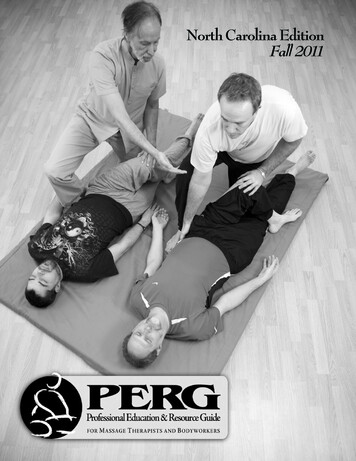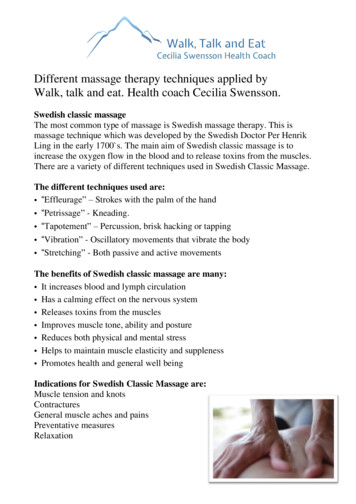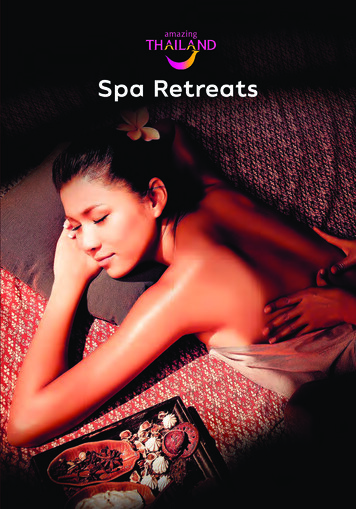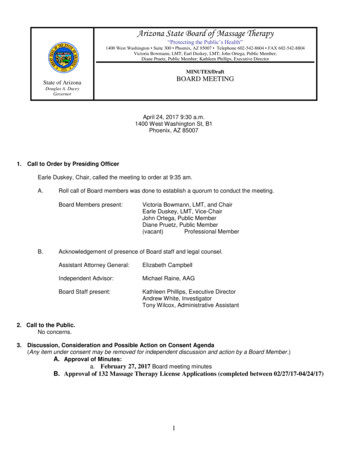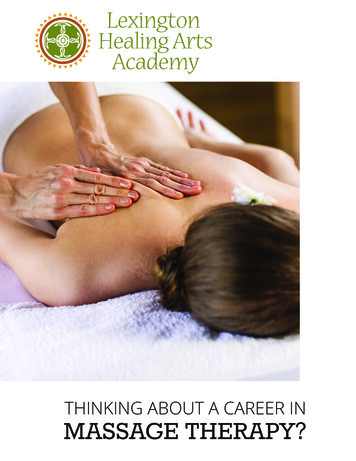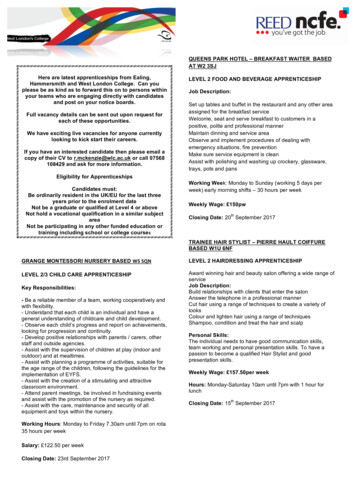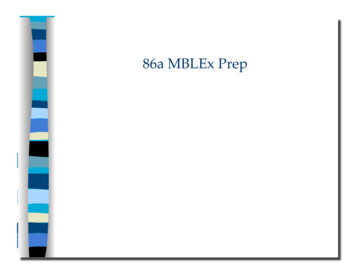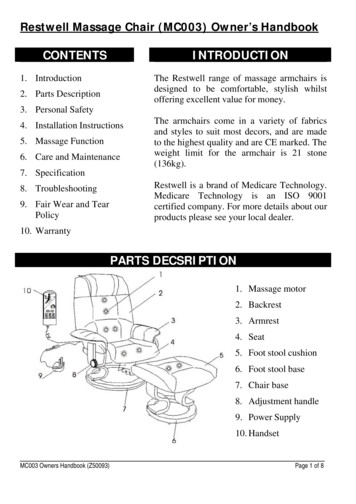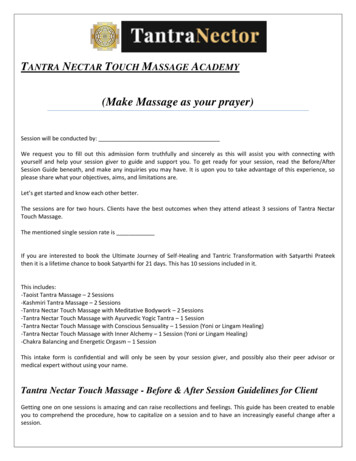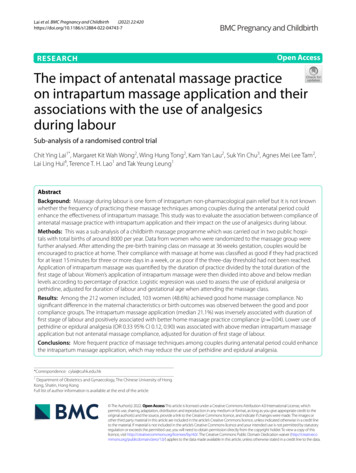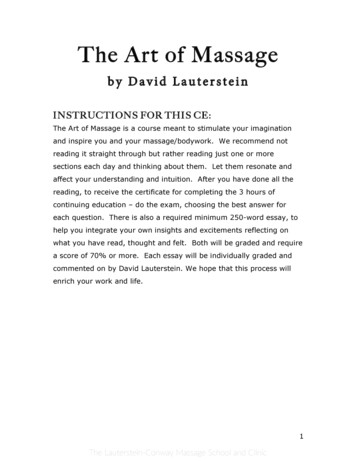
Transcription
The Art of Massageby David LautersteinINSTRUCTIONS FOR THIS CE:The Art of Massage is a course meant to stimulate your imaginationand inspire you and your massage/bodywork. We recommend notreading it straight through but rather reading just one or moresections each day and thinking about them. Let them resonate andaffect your understanding and intuition. After you have done all thereading, to receive the certificate for completing the 3 hours ofcontinuing education – do the exam, choosing the best answer foreach question. There is also a required minimum 250-word essay, tohelp you integrate your own insights and excitements reflecting onwhat you have read, thought and felt. Both will be graded and requirea score of 70% or more. Each essay will be individually graded andcommented on by David Lauterstein. We hope that this process willenrich your work and life.1The Lauterstein-Conway Massage School and Clinic
Table of red” States15A Poem About Massage18Believing in Touch20Body Questions22Breath23Destiny Made Visible25Diaphragms of Life27Don’t Lose the Music30Eternity32Evaluation as Act of Mercy34Facial Diaphragms35Galea Aponeurotica37God’s First Language39Growing New Arms40How the Radiologist Changed My Life42In Every Pause43Is Pain Your Friend?45I Saw the Angel47In Work We Know49Lifting off Your Head50Look at Me!51Loving Time53Massage at the Red Sea54Mind-Body Adhesion562The Lauterstein-Conway Massage School and Clinic
Nine Ways Time Holds the Key57Ode to Piriformis59Ornaments and Crime61Proust was Wrong63Reflections on Fascia and Change65Re-making Faces67Rhythm’s Role69Silver Linings and Inner TreasuresSocial SubluxationSpirit Outlets in Bodywork and Life10 Reasons to Love Gluteus Maximus TheAla, Your Pelvic WingsThe Antidote to PainThe Art of MeetingThe CallingThe Joy of StandingThe Lucky 7 on the Bottom of Your FootThe Massage Client Who Didn’t Like TouchThe Need to TouchThe Silent Mind in MassageThe Two Mothers of Deep MassageThe Wild ClientThe World Beyond UnderstandingTouching with Human Presence24 Ways to Say the Heart is My HomeWhat If You Let Go of Every ‘Should’What is Better than a Guitar?What the Hands Tell MeWhatever Treasure is 053The Lauterstein-Conway Massage School and Clinic
When Clients DisappearWhen I Touch the RibsWhen You Hear MusicWhere No Words Can GoWho Took the First Breath?Windows of LifeWrestling with the AngelYou can’t work on the Same Person TwiceYou Have the TouchZen of BreathAddendum – “Energy and the Integrative 1374The Lauterstein-Conway Massage School and Clinic
ACKNOWLEDGEMENTSI want to thank my teachers: Keith Kartman, my first guitarteacher, Herbert Brün, my music composition teacher at University ofIllinois, Paul Brown, psychotherapist and eventual consigliere, BobKing, my first massage teacher, and Dr. Fritz Smith, the founder ofZero Balancing, with whom I have studied for the past 35 years. I amgrateful to the students, staff and teachers at The Lauterstein-ConwayMassage School. I am grateful to my parents, Aubrey and Faye, andmy Godmother, Millie Barry, all of whom instilled in me a connectionand respect for deep learning and soul. I thank my family, Cherry,Katja, and Jake. And to my wife, Julie, most of all, who with her heartand her own art shows me every day how dedicated and creative onecan be in this life.Back to Table of ContentsThe Lauterstein-Conway Massage School and Clinic5
PREFACE“A symphony must be like the world– it must contain everything.”- Gustav MahlerOften you hear or read that massage is an art and a science. Massageschools curricula generally cover the science needed to knowledgablydo massage. However, that massage is also essentially an art issomething which the field has never clearly and fully articulated,tested for or taught.If a symphony must “contain everything”, how much more true is thatfor the compositions that are our sessions. Our medium - rather thanjust being notes – is the whole psychophysical human being.Just as music depends on the acoustical universe, we depend upon thewondrous structures and functions of anatomy and physiology.Music uses volume, quality of tone, accuracy of tuning and technique,notes’ duration, rhythm, and instrumentation. The science-based artof massage uses pressure, quality of touch, accuracy of knowledge andtechnique, strokes’ duration, rhythm, choice of instrument – thumb,palm, fingers - and the harmonious use of two hands, as in a Bachtwo-part invention for piano.“The human hand, acting in concert with the heart, mind andspirit, is arguably the most sophisticated tool in the known physicalBack to Table of ContentsThe Lauterstein-Conway Massage School and Clinic6
universe. With its pressure and warmth, guided by intelligence, careand inspiration, we can work with musclesand fascia, literallyremodeling the human form and dramatically altering each andeveryhuman function.”-- The Deep Massage BookOur manual art is applied to the unique themes and variations thatconstitute every human being. While the overall themes of human lifeare common – musculo-skeletal structure, cerebral organization ofsensation, movement, emotion, and thought – the individual variationsare infinite. Each person is a unique symphony of being. When wetake a history, we hear a symphony.The Art of ChangeThe great movement teacher, Moshe Feldenkrais, said, “A person cannot change unless they have a new experience.”Of all forms of healthcare, massage therapy is the most direct form ofnew experience – since it takes place in the conscious body. Becauseof its directness, the new experiences evoked by massage, give clientsgreat opportunities, perhaps the greatest existential leverage they canhave.Therapists help people step out of the field of repeated predictableexperience into a new world. To paraphrase the philosopher, GastonBachelard, “One would say that touch, in its newness, opens a futureto experience.”Back to Table of ContentsThe Lauterstein-Conway Massage School and Clinic7
What is astonishing is how often clients come to us having completelyforgotten or never having known what miracles they are anatomically,physiologically, and psychologically. They have often lost the sensethat it is an incredible gift to be alive.The Role of Beauty, Goodness and TruthSo when giving a massage, the therapist has the responsibility to helpreawaken the person to their living beauty; to help them to feel thepresence of goodness; and to help them recognize important innertruths.We respond to the client’s accumulations of past stresses and to theiruniquely developed virtues. We work attentively in the present, theonly time in which we act. And we facilitate a better future by helpingthem remember and mobilize the incredible capacities they have inbody, mind and spirit.Restoring the important inner knowing - that each being is a miracle is not hard! All we need do is ourselves work with respect and wonderand the knowledge of anatomy to reawaken the person to the marvelthat he or she is! In touch, wonder is coupled with joy.Simply touching with clarity, we restore the person to the experienceof who they most deeply are. As the writer Jacques Riviere said, “Thisis indeed that unknown person I was – and so close to me!”So often people are pre-occupied with outer beauty and appearances.But without the experience of inner beauty, of the beauty of lifeBack to Table of ContentsThe Lauterstein-Conway Massage School and Clinic8
radiating from within, appearance means little. A good therapist willrestore the person’s being in touch with being beautiful inside. What‘divine’ creations we are!In the Bible it says that the human is created in the image of God.This has to be more than just a figure of speech! Leonardo took itseriously, so did Michelangelo – so should we!“I saw the angel in the marble and carved until I set him free.” MichelangeloWe need to recognize and cultivate the wonderful role goodness playsin our work. The direct application of kindness is the essence ofmassage therapy. Whereas the application of paint to canvas, or pento paper can have a loving quality – the application of touch to theliving body and mind of the client calls upon a kind of kindness thatitself we know to be healing.As therapists we get to do good. We get to put our clients in touchwith the beauty that lives within them. We help them to experiencemore deeply the truth of their aliveness. Each person is a walkingmiracle. Each person is a masterpiece.As Dante said, “Nature is the art of God.” If that is true, then eachperson is part of this divine art made from life.Tips for Therapists Get Feedback – unlike paints and notes, our medium is intelligentBack to Table of ContentsThe Lauterstein-Conway Massage School and Clinic9
and can tell us if our work is inspiring them! Brilliantly elicitingand responding to feedback can almost guarantee that you canoptimize the experience in every single session. Every session isa collaborative artwork. Listen – with your hands. What is the body is telling you? Whataccumulated past tensions call for your attention? Make sureyou palpate each place with care before choosing and applyingtechniques. Call and Respond. Like a jazz duet/improvisation, two playersmake the session together. Find important places to pause,giving the client crucial time to do their inner work undisturbed.Don’t call without allowing time for the response! Accuracy – Enjoy regularly refreshing and refining your knowledgeand visualization of anatomy and physiology. The foundation forthis art is a deep and thorough understanding of the muscles,fascia, bones, joints and nervous system. Find just the right pressures at just the right moments. Take outthe looseness – pause – press into the tension – pause – sink in– hold – monitor for response – clearly disengage.“Time is what we are made of” BenFranklin Be creative in your choice of duration and rhythm of strokes.Slowing down and letting a stroke seem to last forever can giveBack to Table of ContentsThe Lauterstein-Conway Massage School and Clinic10
your client a window into eternity. Take them out of theexperience of “chronos”, chronological clock-time, into sacredtime – known as “kairos” in Greek. Then, going more quicklythrough non-problematic areas will communicate a sense oflightness and celebrate the fact that the person is not a problemto be solved, but is fundamentally a healthy being with tensionshere or there.Tips for Massage Clients Remember you are more than a body. Be open to receiving in away that is of optimum benefit to yourself. As much as you are comfortable with it, let your therapist knowthe sources of stress in your life and in your body. He or shecan then make emphases that will provide the best benefits foryou. Most of us are so focused on doing, giving our energy to homeand work tasks, that we have lost the healthy ratio of giving toreceiving. Feel free to just let go and deeply receive! Notice new experience – you are a wonder! Feel how much youlearn about your structure, balance, energy. The manipulativeeffects of massage will last a while; the learning from a massagewill last forever. Get out of your head! Enjoy the balance that comes from highquality attention to the vastness of life below your mind.Back to Table of ContentsThe Lauterstein-Conway Massage School and Clinic11
“Love means you breathe in two countries” - Naomi NyeAs is the case for all great art, a great massage will have a deepimpact on our being. Like a wonderful poem, movie or piece of music,a great massage will re-inspire and empower us to be ourselvescreative. It will help us feel more in touch with what is beautiful andmiraculous about the remarkable gift that is human life. It will help usreceive the good with gratitude - the gift of the caring touch of thecreative therapist. It will remind us of deeper truths and importantknowledge that reside within.Andrew Taylor Still, the founder of Osteopathic medicine, said, thebody contains all the healing substances it needs. This holds true formore than just body. Each person contains the healing resources inbody, mind and spirit that he or she needs.The art of massage involves helping the person remember that weourselves are capable of creating ourselves anew. The capacity to selfevolve is unique to the human species.To practice this level of massage is our honor, our opportunity and ourresponsibility. To receive this quality of touch, this quality of kindness,changes the world.Back to Table of ContentsThe Lauterstein-Conway Massage School and Clinic12
A CCURACY“Art and Science cannot exist but in minutelyorganized Particulars” - William BlakeOne of the legs we stand on is the knowledge the biological sciencesgive us. If we can’t find a love and fascination for anatomy, weprobably have no business being massage therapists.All the modalities bandied about to great acclaim and profit aremostly simply applied anatomy. All our ideas arise from this greatform, the human body.Therefore, simple accuracy goes a long way in creatingtherapeutic benefit and the artful experience of touch. This develops inseveral steps, each of which we repeat when we learn anything new.First comes imitation. We repeat the words our teacher or textbookpresent us with. We observe and imitate what they show in palpation.Second comes memorization. I see many students wanting tojump over this step. But the act of placing something like the wordsand notes of a song in your mind so that they take up residence inyour mind, body and soul is a giant step. Placing the visualization andwords for each muscle’s origin, insertion and action is a sacredobligation.Third comes embodiment. You know the anatomy so well thatyou don’t have to “think” about it to have accuracy in your touch. Yourwork has “a hesitant touch which doesn’t make mistakes anymore”. Inother words, some of your anatomical knowledge now residescomfortably within the cerebellum where movement programs arestored.Fourth comes therapeutic relationship. When we do not need tospend much energy consciously recalling where the muscles are andBack to Table of ContentsThe Lauterstein-Conway Massage School and Clinic13
what they do, then we are free to let more of our awareness bedevoted to understanding this unique person and how we need totouch them to be of optimum service.Like a muscle – what might be the details of the origin of thisindividual client’s pain and tension and strength? Now that I can pluckthe notes in the sinews with accuracy, what is going to be the healingmusic?Each session is a call-and-response. It is this deep listening andnonverbal conversation that provides marvelous therapeutic results.A study was done of people who improved with psychotherapy.They discovered that it was not correlated with the psychotherapeuticapproach – be it gestalt, Freudian, bioenergetic, Jungian, etc. It wasdirectly correlated with this – the quality of the therapeuticrelationship of client and therapist.So, exacting loyalty to the miraculous structure of the humanbody leads us ultimately to cultivate the optimum quality ofrelationship to the whole person, that results in the client’s restoring adeep experience of health throughout their own body, mind and spirit.Are you not a miracle?!Did You Know: In one square inch of our hand, we have ninefeet of blood vessels, 600 pain sensors, 9000 nerve endings, 36 heatsensors and 75 pressure sensors!Question - Why is it that touch is so powerful?"No other sense deals as directly with the three-dimensional world orsimilarly carries with it the possibility of altering the environment inthe process of perceiving it; that is to say, no other sense engages infeeling and doing simultaneously."Charles Moore - Body, Memory and Architecture -Yale University PressBack to Table of ContentsThe Lauterstein-Conway Massage School and Clinic14
“A LTARED” STATESI have always enjoyed my massage tables. They are efficientand beautiful tools of our trade.I recently returned from a weeklong “yoga vacation” at awonderful center in Tulum, Mexico – Maya Tulum. During that time Ireceived three massages, each excellent. After my first massage, Ihappened to meet a young, friendly man who introduced himself asLeo. I had heard high recommendations of his work from other peoplein the retreat – so I decided to sign up for a massage from him as mylast session there.In that session, something happened that may change how Iperceive and give every massage from now on. I had signed up for atraditional Mayan “Yoot Keen” Massage.Leo began with some quite deep and specific abdominal work. Itwas interesting, as deep abdominal work often seems to bring upsurvival issues. I believe this is due to its being the largest vulnerablearea of the body having little bony protection. And of course itcontains our “vital organs.” So Leo’s work here was a somewhat edgy.I had a little anxiety and mild discomfort in a few places, but overall itfelt just like good deep abdominal work.He then continued, working with me in a supine position,expertly covering the legs, feet, chest, arms, hands, neck and headwith good, solid very three-dimensional work. Then he asked me toturn over and soon after turning over I had the distinct experience thatI was no longer on a massage table.What I felt then was that I was rather on an altar! The rest ofthe session I experienced not on a massage table – I felt distinctly thatI was on an altar. As such everything he did seemed to have a sacredBack to Table of ContentsThe Lauterstein-Conway Massage School and Clinic15
context, as well being physically effective. I felt more dramatically thefreeing and aligning of my physical structures. I also felt an easy,organic flow of memories – as if past events in my life were circulatingthrough me as well – releasing old no longer useful patterns andamplifying gifts from the past that I could yet own more deeply. Soboth time and space were being freed within.Most striking overall though was that overriding experience ofbeing on an altar. And I now realize that there can be, much moreconsciously than I’ve previously cultivated, a very natural, yet verysacred aspect to massage. Altars are indeed basically not so differentfrom any other table, study desk, massage table, a dinner table, orotherwise. The main difference is that we place on them objects ofreverence, things that remind us of or may evoke a sense ofsacredness.If the client is on the altar, then every stroke has a sacreddimension. This doesn’t require any pretense – only the awarenessthat just as massage affects the body, and sometimes the mind, it canequally affect the spirit. And when the spirit is affected positively, itmakes the context “sacri-ficial” (meaning literally “to make sacred”).The table then may function, in such moments, however brief orextended in duration, as an altar.Spirit can mean many things, to many people. To me it isconnected to the sense that this life is a gift. It is not ego-centered –spirit is not mine. It can manifest just as a sense of gratitude. It maybe felt as a sense of energy flowing through us. Or it just may be theelation and natural ecstasy explored wonderfully in Robert Johnson’sbook, “Ecstasy: Understanding the Psychology of Joy.” In that book,he talks about the human need for experiences which transcend oureveryday reality and these experiences fundamentally nourishing ourBack to Table of ContentsThe Lauterstein-Conway Massage School and Clinic16
being. We all have moments when we feel transfigured byexperiencing the beauty of the natural world or of great art.To have the spirit touched awakens us to our own sacredness, our ownmiraculous nature. It turns the therapist to that extent, without theintention to do so, as well, into a bit of a spiritual guide through thework of his or her own hand, heart and spirit. It should be said Leosaid nothing during the massage, so there was no “programming”going on.Every session is an opportunity to revitalize the body, mind andspirit. If we will recognize that our tables may function as altars, andthat we may be contacting the client spiritually, our clients stand thento receive the fullest benefits therapy may offer.Of course, it is tricky not to impose this vision onto the client. Isuggest only that we remember, from the very beginning of meetingthe client to the very end of the session, that this spiritual dimensionand benefit to massage may accompany the physical, emotional, andmental benefits. That’s just common sense.This common sense, nonetheless, allows us, from the get go andthe let go, to see that we are allowing and inviting gently into everymassage we give, to some extent, a dimension in which our clientsmay experience the “altared state”.Back to Table of ContentsThe Lauterstein-Conway Massage School and Clinic17
A POEM ABOUT MASSAGEHands touching places never touched.Forearms with a river flowing between two bones.Panning for the gold in your hands,I find reflections of everyone you’ve been –the heavenly queen,the knight whose armor shone in the sun,the sleeping child with handslike kittens on top of each other,the serf whose shoulders bore the plow.“Your feet, my dear,” he said, “are alphabetical.”26 ways to say, “The earth is my home.”A bone for each week of the year,Phalangeal months,Pedal astrology:Leo meets the Longitudinal ArchesAnd Capricorns like hooves.All the stars make waves everywhere inside of you.It’s not enough to say,This shoulder is beautiful,And that hip leaves nothing to be desired.The ball and socket speakIn an Oriental language of completeness and freedom,Movement through the union of opposites.Back to Table of ContentsThe Lauterstein-Conway Massage School and Clinic18
Ribs float in the air,Summer nights the boughs moveMore gently in the breezeAnd your breath persuades my heart to love.It is impossible that hair is not tall grass,Impossible that wind is not breath,That your legs are not panther legs,Your head not a falcon’s.There are too many people in this worldNot to love them all.Hands alight –Lotus petalsOn the abdomenWords point to what we can not say,What we can not speak of, we hope to touch.Touch the world.You call it therapy.I call it love.Back to Table of ContentsThe Lauterstein-Conway Massage School and Clinic19
B ELIEVING IN TOUCHI have never been a very religious person. My father was an agnostic,who also liked jokes. So, at his funeral, I said, “He didn’t believe muchin religion but he loved jokes. So, Dad, if you can hear me now, thejoke is on you.”From an early age I did have a respect and attraction to thesacred, often through art and music, and also from a deep hope thathumans would collaborate in creating a peaceful world.I was intrigued by the experience of spirit or energy - doing yogaon my own when I was 16, I had a first experience of dramaticsensations of energy flow in my body. Then I spent countless hourslistening to and playing music of all kinds, mostly blues and rock androll - I loved the moments when the guitar seemed to be playing me,not the other way around.I studied Asian music in Berkeley in 1967 and remember anastonishing concert of a Japanese shakuhachi (bamboo flute) masterin which somehow we were all transported into a dense forest with adeer running through it.I graduated with a degree in music composition, but didn’t findthat satisfying as a profession. So I got into therapy and read a lot inthe realms of psychology and eastern and western philosophy.Eventually I got a job at my favorite bookstore, the Whole EarthCenter in Evanston, Illinois.In 1974 I was at a bookseller’s convention in Atlanta and waspleased to meet the people who made the “Dharmaseal” decals thatwe sold at our center. They were disciples of Richard Alpert “RamDass”, himself a devotee of an Indian teacher. On the second day, Iwent to talk with one of the Dharmaseal people, Miribai, but she wasBack to Table of ContentsThe Lauterstein-Conway Massage School and Clinic20
busy with a customer and, touching me on the shoulder, apologizedfor not being able to talk at that moment. I walked down the aisle a bitdisappointed. As I walked, I started to feel better. Then much better.Then incredibly well! I felt that there was a sun inside of me, radiatingout from the core of my being. Eventually I was almost surprised thatother people couldn’t see it. That moment was my first big “crack” inthe cosmic egg.I thought if just a single touch can affect a person thatpowerfully, I want to learn more about that! That led to me becominga massage therapist, then a massage teacher, moving to the kinder,gentler community of Austin in 1984, then eventually to starting aschool, The Lauterstein-Conway Massage School, in 1989.I still don’t practice a particular religion; the closer I get to theformality of any one, the less I am inclined to proceed. But I havelearned from the Jewish, Christian, Sufi, and Buddhist traditions. Butprobably the most I have learned is from massage therapy. Fromworking with the body and the way it connects to and affects the mind,emotions and the spirit, I have learned most of what I know andvalue. I am tempted to say I’m a practitioner of Massage-ism.The insights which come from studying and practicing massageare, to me, the missing piece in our culture and in our education. Thevalue of kindness, the respect for boundaries, the knowledge andvaluing of the miraculousness of our anatomy and physiology, thecultivation of clear and high quality relationship within the setting oftrue heath-care for the whole person, the role that healthy touch canplay in our world – these are just some of my learnings.I thank my teachers and lucky stars to have found a path that Ican walk with enthusiasm and gratitude – the world revealed to us byour bodies and healthy touch. I believe in touch.Back to Table of ContentsThe Lauterstein-Conway Massage School and Clinic21
B ODY QUESTIONSThe curiosity implicit in the tensionswe introduce poses questionsThe brilliant teacher, Seth Godin wrote, “To earn our attention, thereneeds to be tension. The tension of how it might turn out. The tensionof possibility. The tension of change. Telegrams used to charge by theword. Say what you need to say, there you go. But stories. storieswork because we're not sure. We're half there, half not. This mightwork. This might not work. The tension of maybe”.When we contact or introduce tension into the body, it is as if weare asking a question of it, the conscious and unconscious body.When we go to our edge in a yoga pose, we are asking, can you dothis? Can you sustain this? Can you be ok with this being your limit?When in massage we press in and with precision contact tension in amuscle or find tension in a ligament through a stretch, we are asking,can you let go here?And then the body begins to tell its stories in feelings,sometimes in words – I can’t let go here because of what the world didto me as a child, because of the news, because of work, myrelationship, what I believe about myself, because I don’t want tochange Often we don’t hear these actual stories, but we know the bodyis re-acting them in its response to tension.The curiosity implicit in the tensions we introduce posesquestions and evokes our stories. The question asks us whethermaybe we can find new ways to be?These stories of ours are ongoing and can have different endingsin body, mind and spirit.Back to Table of ContentsThe Lauterstein-Conway Massage School and Clinic22
BREATH“Everything must touch! Send feelers out, Andlove is like a vine, it is connecting us.”What connects one touch with another? What role does breath play inthe art of massage?In yoga, if we do the postures and movement without fullbreathing, it is of limited structural and energetic benefit. If we danceand don't breath fully and naturally, we move in a stilted way, So tooif a therapist does a massage without fully and naturally breathing inand out, it's like song without the right rhythm, it feels held back,stilted, you don't feel like singing along. Without the free breath of life,the massage will likely not have a deeper therapeutic impact.When we do and teach massage, too often the concentration is overlymuch on what we do with our hands. But - our energy doesn’t comefrom our hands! It comes from breath. Literally and figuratively,breathing fully in and out gives us aliveness in every cell, pulsation,and a sense of volume in our bodies as we move. Breath is the firstand last nourishment. It is the breath with which we nurture andnourish our clients.Plus the only inner rhythm that we have both conscious andunconscious control of is the breath. The brainstem gives us the basicbreath but we also have learned habits and voluntary control throughthe cerebrum, the home of the conscious mind. Thus, through both themedullary and cerebral influence of breath, we access the explicitinterface of both the conscious and the unconscious worlds.Respiration is the deepest physiological and anatomical functionover which we have conscious as well as unconscious control.The slow rhythm of freed, mindful breathing conveys a sense ofgrace. Just like the most wonderful, the warmest breeze, breath willBack to Table of ContentsThe Lauterstein-Conway Massage School and Clinic23
convey exquisitely a sense of ease. It will be a slow rhythmic, livingvehicle for taking an important vacation from the rhythms and tasks ofeveryday life.To find the energy and responsive rhythm in a session with aclient, we need to fully inhabit our own breath and be mindful of thedepth and rhythm of theirs. Then the massage is a duet of breath. It isthe experience of harmony between two people. The philosopher,Krishnamurti, said if six people would totally cooperate, the worldwould be instantly transformed. Maybe we can say, for the world to betran
King, my first massage teacher, and Dr. Fritz Smith, the founder of Zero Balancing, with whom I have studied for the past 35 years. I am grateful to the students, staff and teachers at The Lauterstein-Conway Massage School. I am grateful to my parents, Aubrey and Faye, and my Godmother, Millie Barry, all of whom instilled in me a connection


